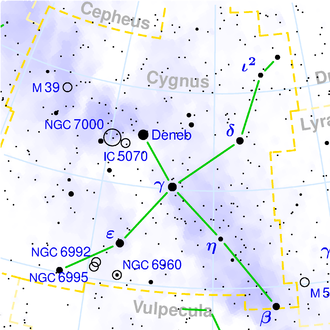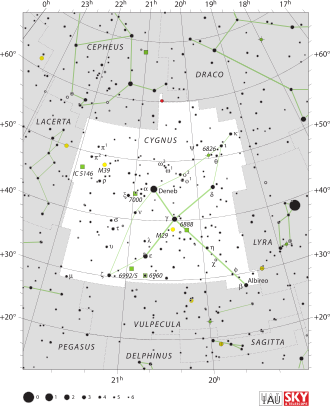Cygnus (constellation)
Cygnus is a constellation in the northern sky. Cygnus means "swan" in Greek.[1] There is a pattern of stars in Cygnus that is called the Northern Cross. This is because the pattern of stars looks like a cross. The constellation Crux (constellation) has a pattern of stars that is called the Southern Cross. The astronomer Ptolemy listed Cygnus in the 2nd century when he made a list of constellations.
 Click for larger image | |
| List of stars in Cygnus | |
| Abbreviation: | Cyg |
| Genitive: | Cygni |
| Symbology: | |
| Right ascension: | 20.62 h h |
| Declination: | +42.03° |
| Area: | 804 sq. deg. (16th) |
| Main stars: | 9 |
| Bayer/Flamsteed stars: | 84 |
| Stars known to have planets: | 57 |
| Bright stars: | 4 |
| Nearby stars: | 1 |
| Brightest star: | Deneb (α Cyg) (1.25m) |
| Nearest star: | 61 Cyg ( ly) |
| Messier objects: | 2 |
| Meteor showers: | October Cygnids Kappa Cygnids |
| Bordering constellations: | Cepheus Draco Lyra Vulpecula Pegasus Lacerta |
| Visible at latitudes between +90° and −40° Best visible at 21:00 (9 p.m.) during the month of September | |
Deep-sky objects
Famous stars
Cygnus (constellation) Media
Cygnus as depicted in Urania's Mirror, a set of constellation cards published in London c.1825. Surrounding it are Lacerta, Vulpecula and Lyra.
On the left side of this X-ray image are the bright North America Nebula (left bright part) with Sadr region (right bright part) in the Cygnus X region, visually interrupted by the Cygnus rift*.
The constellation Cygnus as it can be seen by the naked eye, with the Northern Cross in the middle.
V1331 Cygni is located in the dark cloud LDN 981.
The two component stars of Albireo are easily distinguished, even in a small telescope.
The North America Nebula (NGC 7000) is one of the most well-known nebulae in Cygnus.
Cygnus X, a large region of star-formation in Cygnus
Diagram of the Milky Way's spiral arms
References
- ↑ "Cygnus (swan) also (modern) Northern Cross". Harvard. Retrieved 27 January 2013.










